![]() Turkish
Coat for Venetian Dress
Turkish
Coat for Venetian Dress ![]()
*Thank you to Becky, SCAKA Aclisto, for contributing images *. The argument for Turkish coats in Venetian dress just got stronger.
Each of these Venetian portraits show what appears to be a Turkish coat being worn by the subject. Venice being the crossroads between east and west had many dealings with the Turks, some good and some not so good.
Textiles from the east are the first thing that springs to mind of the good things from those parts. Perfumes, oils, spices, dyes and silk are probably the best known of the eastern exports.
Just as there was a Jewish sector of Venice in the sixteenth century there was also a Turkish sector. When viewing these Venetian portraits of the time showing Venetian women wearing Turkish coats then comparing them with Turkish images of the same time it is not hard to see the influence from east to west.
A look a the Turkish Images.
Note the flag fan in the left hand image, also seen in Venice at the time. Additionally the magnificent colours of the textiles. The coats in these images have no evidence of pleating displayed, all would appear to get the fullness at the hem from the cut of the coat rather than the gather of extra fabric. The upturned skirt of one from the colour plate as well as the turn back on another would suggest a lining of a different fabric and finished edges with another textile, possibly bias strip. Finished lengths all appear to be ankle length.
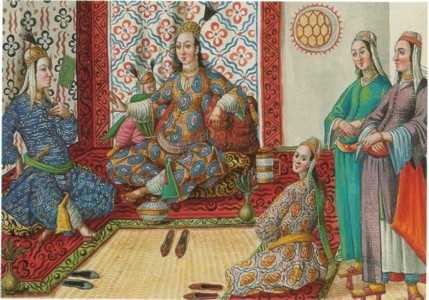 |
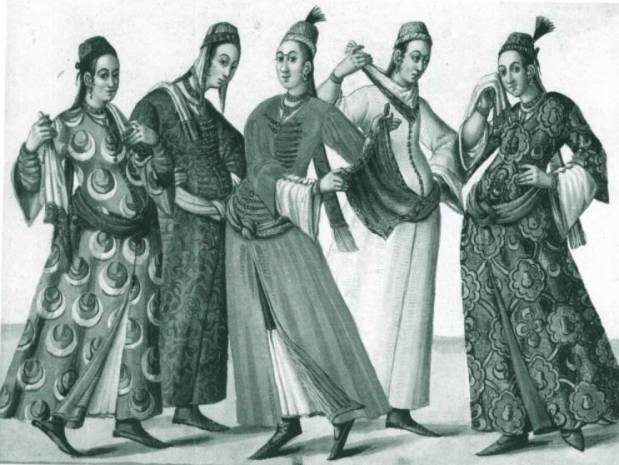 |
| Harem, codex Vindobonensis 1590 Osterreichische Nationalbibliothek Vienna. | Codex Vindobonensis' late 16th C Austrian National Library Vienna |
|
|
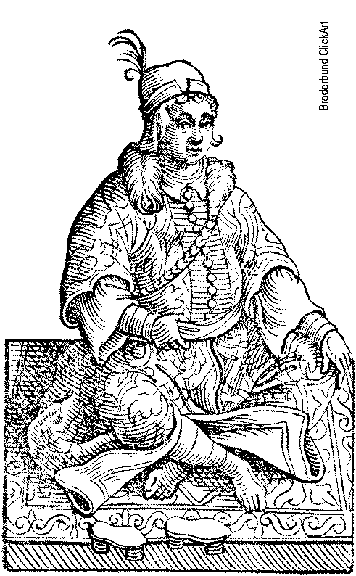 |
| Cesare Vecellio's Costume Plates Circa
1590
Middle class Turkish woman in street dress |
Cesare Vecellio's Costume Plates Circa
1590
Turkish woman at home |
The large patterns on the textiles could be either a brocade or embroidery. The ottoman empire did seem to treat both brocade and embroidery in simular fashion, large stylised floral and geometric patterns. These were adopted and adapted by the Europeans when they established their own textile industries for higher quality brocades etc.
The actual fibre content, well silk is a widely known and used fibre in this region thus making it entirely likely to be present in textiles. Wool, linen and cotton were also used in the east and exported to the west. I favour silk, something about the term 'silk route' that makes this an obvious choice as far as I'm concerned.
A Possible Pattern lay out.
The enlarged patterns on the link from the below image is easier to see. ( from the site of E. A. Young http://fenris.net/~lizyoung/16thCePers/16thCePersian.html probably scanned from Croutier, Alev Lytle. Harem: The World Behind the Veil. New York. Abbeville, 1989 ) This is the basics of the pattern I used with the inclusion of facings and differently shaped sleeves.
Thanks to Lyonet for reminding me where I found this pattern.
A closer look a the Venetian Images.
In each of the Venetian images there are certain similarities.
The sleeve shape. The sleeves are all truncated and have a point that falls to the front of the arm with a raised section to the centre position of the sleeve. This would led me to suspect that the point is reflected in the back of the sleeve also. The necklines. Each have a smooth V neckline with a Embellishments. Heavy embellishment at the opening of the neckline and the sleeve opening. Bejewelled pieces along with beads that could be pearls or of glass are used to show off.
Finished length. As each of the Venetian portraits are truncated at the thigh we can only speculate on the actual finished length. If compared with the Turkish images it is reasonable to recon on the length being to the ankle, but not to the floor.
|
|
|
|
Portrait of a Lady, 1555 By Titian. Meant to be Queen Catherine of Cyprus of 1492. |
Detail showing the use of fine gold lace at the edge of the carmica, and the embellishment at the edge of the coat. |
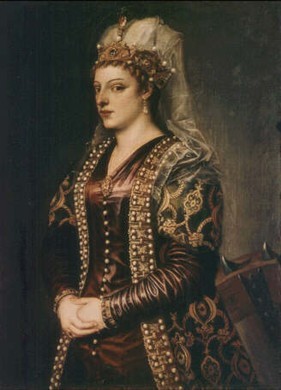 |
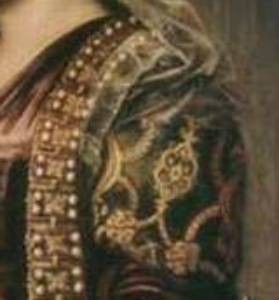 |
|
CATERINA CORNARO of Venice became Queen of Cyprus 1492 ? Titian as it is extremely similar to the treatment as the previous portrait. Definitely not painted in 1492! |
Detail showing the shape of the sleeve and the front opening detail. |
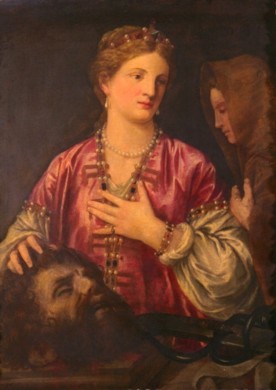 |
|
|
Cameria, daughter of Suleiman the Magnificent, as St Catherine. By Titian date and location unknown. |
Venetian, Titian, unknown location, loose gown. Appears to be a 'Judith with the head of Holofernies', or "Salome with the Head of John the Baptist" |
All
intellectual content, composition, layout, designs and photographs, unless
otherwise noted are copyright 2007 to Deborah
Lane ©,
or, copyright 2003 to Deborah Murray
©
also known as Mistress Oonagh O'Neill ©.
All Original renaissance art works and artefacts are not copyright to me, and
are shown for educational use only . If you see something you'd really
like to use, please contact me!
